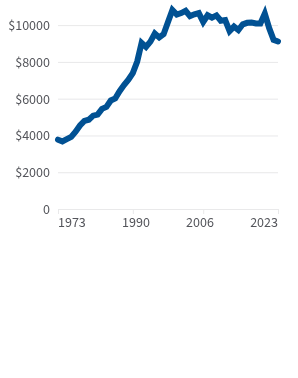JUST THE FACTS · 7:15M
2. What is Medicaid and how many Americans use it?
October 14, 2025 · Nearly one in four Americans rely on Medicaid, making it the largest health insurance provider in the US — but many people don’t know how it really works. In the second episode of “Just the Facts: Do You Qualify?”, USAFacts founder Steve Ballmer explores Medicaid: who it covers, how eligibility is set, and why it’s the single biggest budget item in many states. You’ll learn how the program supports low-income Americans, how states decide who is eligible, and what the Big Beautiful Bill means for Medicaid. We’ve read the fine print (and the footnotes), so you don’t have to.
Just the Facts: Do You Qualify?

2. What is Medicaid and how many Americans use it?
(current video)
7m
Transcript
Over 1 in 4 Americans rely on it. But many people don't really know how it works. We're talking about Medicaid, the single largest health insurance provider in the country.
And every political cycle. It's up for debate in Washington, including recent changes made in the One Big Beautiful Bill Act.
How much should the government spend on Medicaid, should it exist? Should it be expanded?
The program helps Americans get and afford medical care. But who qualifies? What does it cover? And how much does it cost?
Just the Facts: Do You Qualify? A look at Government Support in America. A six-part series from USAFacts. In this episode: Healthcare.
Medicaid is a public health insurance program for people with low income.

It was signed into law in 1965 by President Lyndon B Johnson as part of his war on poverty.
People frequently confuse Medicaid with another government insurance program, Medicare.
But these programs are very different. Medicare is fully run by the federal government and serves seniors regardless of means.
Medicaid is a joint effort between the federal government and the states, covering everything from emergency room visits to prenatal checkups for those with limited resources.
Who is eligible for Medicaid? That’s a bit complicated.
States decide who is eligible for Medicaid, but they have to commit to covering certain populations to get federal money.
In 2023, state governments covered 31% of the total cost of the program, but state contributions covered from 40% in Wyoming to just 18% in New Mexico.
In 2010, the Affordable Care Act extended eligibility to families with children making under 133% of the federal poverty level. It also gave states the option to expand Medicaid to cover families with even higher incomes, and also cover low income adults without children.
The federal poverty level ranges from $15,650 for a single-person household to $54,150 for an eight-person household.
Federal poverty guidelines by family size in the contiguous US (2025)
In 2012, the US Supreme Court ruled that the federal government could not force states to expand Medicaid. So Medicaid expansion became optional. States could opt in or opt out.
As of late 2024, these ten states have still decided to opt out:
- Alabama
- Florida
- Georgia
- Kansas
- Mississippi
- South Carolina
- Texas
- Wisconsin
- Wyoming
Beyond that, each state uses a different income limit to determine eligibility.
Take a single mom in Texas with two kids making $26,000 a year. Right about the poverty line for a family of three.
But to qualify for Medicaid in Texas, she needs to earn less than $3,200 per year. So even though she's working and earning very little, her children qualify. But she is not eligible.
In the state she lives in, she's stuck in poverty, but not poor enough for support.
In Illinois, that same mom qualifies as long as her income is below $35,445.
That's 133% of the poverty line, more than ten times the limit in Texas.
For children, there's another layer of support, something called CHIP, or the Children's Health Insurance Program, designed for kids whose families earn just above Medicaid cut offs but still struggle with private insurance costs.
In most states, it's managed through the same system as Medicaid, and families apply the same way.
So how many people are on Medicaid? Over the years, the enrollment has grown a lot.
In 1973, just 8% of Americans were on it. Today, its over 1 in 4 Americans, though it varies quite a lot by state.
In FY 2024, 26.2% of people were covered by Medicaid.
Average monthly Medicaid enrollment as a share of the population
Looking at the uninsured rate, that is the people who have no insurance, it took a big dip once Medicaid was enacted, but then has remained relatively stable, slowly increasing over time until it went up after the Great Recession.
Then it went down again after the Affordable Care Act was implemented. From 13.3% in 2013 to 9% in 2023.
And as enrollment grew, so did spending.
What used to be a relatively small 2% of the federal budget has grown to more than 9% today, in dollars, after accounting for inflation. That's more than 11 times what it was.
In 2024, the federal government spent $618 Billion on Medicaid. Add in what the states contribute, and the program nearly $900 billion in 2023. That's the most recent year when full data is available, including the states.
In many states, Medicaid is now the single biggest budget item, even bigger than K-12 education.
Federal spending on Medicaid
In July 2025, Congress passed the Big Beautiful Bill, which made changes to Medicaid eligibility including: establishing work requirements for adults with no kids, and parents with kids older than 13; and creating more frequent eligibility checks for those enrolled.
We won’t know the impact of these changes for a while. The changes don’t start until 2027.
New restrictions on Medicaid and SNAP start as early as 2025 under the OBBB
Effectiveness dates for government assistance policies in the One Big Beautiful Bill Act
So, is Medicaid working? For over 1 in 4 Americans, Medicaid is the reason they can see a doctor, afford long term care, or get prenatal checkups.
It has a big impact on millions of lives. But are we getting our money's worth? What changes would make sense? These are important and complex questions, and you have to decide.
Thanks for watching. And please share the entire series. Do you qualify? A look at government support in America.
Subscribe to our newsletter at USAFacts.org and our YouTube channel. At USAFacts, we give you the data. You make up your own mind.
Stay tuned for the next episode: Housing.
Page sources and methodology
All of the data on the page was sourced directly from government agencies. The analysis and final review was performed by USAFacts. Findings were summarized with the help of AI.
Medicaid and CHIP Payment and Access Commission
MacStats
Centers for Medicare & Medicaid Services
Data.Medicaid.gov






